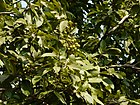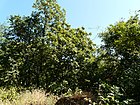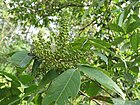Note: This is a project under development. The articles on this wiki are just being initiated and broadly incomplete. You can Help creating new pages.
Difference between revisions of "Sapindus trifoliatus"
| Line 1: | Line 1: | ||
| + | [[File:Sapindus trifoliatus 05.jpg|thumb|right]] | ||
'''Sapindus trifoliatus''' is an evergreen tree with a dense, broad crown. It can grow up to 25 metres tall. The tree is harvested from the wild for its seed, which is used medicinally and as a source of saponins. The seeds are very widely used and are sold in quantity in markets. It is often cultivated for these seeds. | '''Sapindus trifoliatus''' is an evergreen tree with a dense, broad crown. It can grow up to 25 metres tall. The tree is harvested from the wild for its seed, which is used medicinally and as a source of saponins. The seeds are very widely used and are sold in quantity in markets. It is often cultivated for these seeds. | ||
==Uses== | ==Uses== | ||
| Line 57: | Line 58: | ||
==Photo Gallery== | ==Photo Gallery== | ||
<gallery class="left" caption="" widths="140px" heights="140px"> | <gallery class="left" caption="" widths="140px" heights="140px"> | ||
| − | + | Sapindus trifoliatus - South India Soapnut flowers at Makutta (4).jpg | |
| + | Sapindus trifoliatus 04.jpg | ||
| + | Kunkuduchettu (Telugu- కుంకుడుచెట్టు) (3187323105).jpg | ||
| + | Puvanti (Tamil- பூவந்தி) (3092506869).jpg | ||
| + | Sapindus trifoliatus - South India Soapnut flowers at Makutta (1).jpg | ||
</gallery> | </gallery> | ||
Revision as of 16:06, 4 August 2020
Sapindus trifoliatus is an evergreen tree with a dense, broad crown. It can grow up to 25 metres tall. The tree is harvested from the wild for its seed, which is used medicinally and as a source of saponins. The seeds are very widely used and are sold in quantity in markets. It is often cultivated for these seeds.
Contents
- 1 Uses
- 2 Parts Used
- 3 Chemical Composition
- 4 Common names
- 5 Properties
- 6 Habit
- 7 Identification
- 8 List of Ayurvedic medicine in which the herb is used
- 9 Where to get the saplings
- 10 Mode of Propagation
- 11 How to plant/cultivate
- 12 Commonly seen growing in areas
- 13 Photo Gallery
- 14 References
- 15 External Links
Uses
[[:Category:Ayurvedic Herbs known to be helpful to treat |]], [[:Category:Ayurvedic Herbs known to be helpful to treat |]], [[:Category:Ayurvedic Herbs known to be helpful to treat |]], [[:Category:Ayurvedic Herbs known to be helpful to treat |]], [[:Category:Ayurvedic Herbs known to be helpful to treat |]], [[:Category:Ayurvedic Herbs known to be helpful to treat |]], [[:Category:Ayurvedic Herbs known to be helpful to treat |]], [[:Category:Ayurvedic Herbs known to be helpful to treat |]], [[:Category:Ayurvedic Herbs known to be helpful to treat |]], [[:Category:Ayurvedic Herbs known to be helpful to treat |]], [[:Category:Ayurvedic Herbs known to be helpful to treat |]].[1]
Parts Used
[[:Category:Herbs with used in medicine|]], stem, leaves, Root.
Chemical Composition
it contains the major compounds isolated from Sapindus mukorossi are triterpenoidal saponins of mainly three oleanane, dammarane and tirucullane types.[2]
Common names
| Language | Common name |
|---|---|
| Kannada | ಅಂಟುವಾಳ Antuvaala, ನೊರೆಕಾಯಿ Norekaayi |
| Hindi | Phenil |
| Malayalam | Cavakkaay |
| Tamil | Punalai |
| Telugu | Kunkuduchettu |
| Marathi | Phenil |
| Gujarathi | Arithi |
| Punjabi | |
| Kashmiri | |
| Sanskrit | Hrishtah |
| English | South India Soapnut |
Properties
Reference: Dravya - Substance, Rasa - Taste, Guna - Qualities, Veerya - Potency, Vipaka - Post-digesion effect, Karma - Pharmacological activity, Prabhava - Therepeutics.
Dravya
Rasa
Guna
Veerya
Vipaka
Karma
Prabhava
Habit
Identification
Leaf
| Kind | Shape | Feature |
|---|---|---|
Flower
| Type | Size | Color and composition | Stamen | More information |
|---|---|---|---|---|
| {{{5}}} |
Fruit
| Type | Size | Mass | Appearance | Seeds | More information |
|---|---|---|---|---|---|
Other features
List of Ayurvedic medicine in which the herb is used
Where to get the saplings
Mode of Propagation
How to plant/cultivate
A plant of the lowland tropics and subtropics, where it is found at elevations up to 500 metres. It grows best in areas where annual daytime temperatures are within the range 32 - 40°c, but can tolerate 10 - 47°c.[5]
Commonly seen growing in areas
[[:Category:Herbs that are commonly seen in the region of |]], [[:Category:Herbs that are commonly seen in the region of |]], [[:Category:Herbs that are commonly seen in the region of |]], [[:Category:Herbs that are commonly seen in the region of |]], [[:Category:Herbs that are commonly seen in the region of |]].
Photo Gallery
References
- ↑ Indian Medicinal Plants by C.P.Khare
- ↑ Chemical constittuents
- ↑ Common names
- ↑ [Morphology]
- ↑ [ Cultivation]
External Links
- Ayurvedic Herbs known to be helpful to treat
- Herbs with used in medicine
- Herbs with stem used in medicine
- Herbs with leaves used in medicine
- Herbs with Root used in medicine
- Herbs with common name in Kannada
- Herbs with common name in Hindi
- Herbs with common name in Malayalam
- Herbs with common name in Tamil
- Herbs with common name in Telugu
- Herbs with common name in Marathi
- Herbs with common name in Gujarathi
- Herbs with common name in Sanskrit
- Herbs with common name in English
- Habit - Evergreen tree
- Index of Plants which can be propagated by Seeds
- Index of Plants which can be propagated by Greenwood cuttings
- Herbs that are commonly seen in the region of
- Herbs





